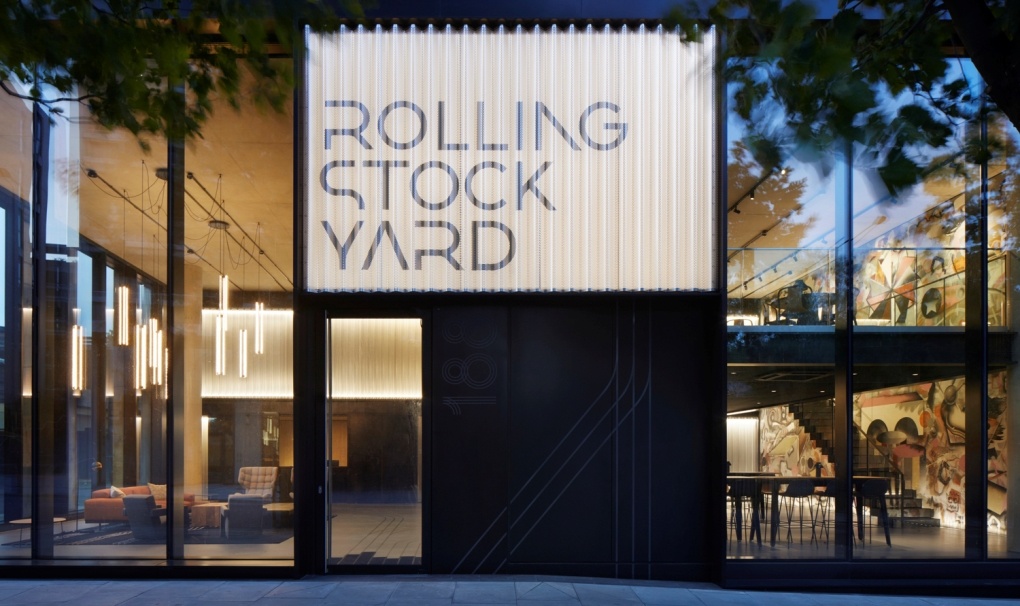In the redeveloping King’s Cross area in the heart of London, England, the Rolling Stock Yard is a new redevelopment project designed as a contemporary response to its industrial setting.
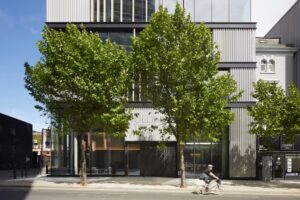 It’s a tricky proposition: on the one hand, you want to complement and enhance the the area to advance its revitalization.
It’s a tricky proposition: on the one hand, you want to complement and enhance the the area to advance its revitalization.
On the other hand, you don’t want to blindly mimic the old style, creating “fake heritage”. Rolling Stock Yard seems to have found a good balance.
The building provides 57,500 square feet of workspace for creative small to medium-sized businesses.
The design concept draws on the area north of the King’s Cross St. Pancras rail station, which historically characterized by transportation, freight, and industry, but now an emerging creative quarter.
Here’s what the architects at Squire & Partners say about their project:
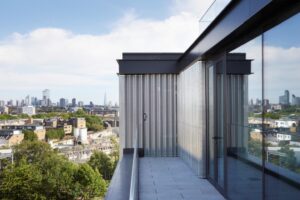 Converging railway lines and shipping containers are referenced in the nine-story building, expressed as a series of stacked elements with a black profiled steel structure emulating parallel railway tracks running horizontally across the facades.
Converging railway lines and shipping containers are referenced in the nine-story building, expressed as a series of stacked elements with a black profiled steel structure emulating parallel railway tracks running horizontally across the facades.
Within this horizontal grid, full-height glazing is softened by a layer of vertical solid oak sleepers and sinusoidal perforated metal screens to offer privacy and shade during daylight hours, and emit a diffused glow at night.
At pavement level, the building animates the street with bespoke illuminated entrance signage behind a corrugated metal screen, and a double-height office entrance addressing York Way.
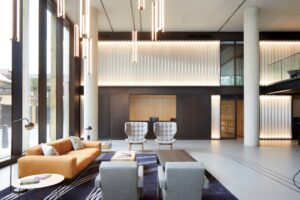 Internally an industrial palette of exposed concrete, blackened steel, and perforated aluminium is balanced by a pair of timber-lined recesses for the reception and café.
Internally an industrial palette of exposed concrete, blackened steel, and perforated aluminium is balanced by a pair of timber-lined recesses for the reception and café.
Unifying the space is a pale grey poured resin floor with inlaid track patterns which define routes from the entrance to the reception, lifts, and café.
For building users and guests, the Rolling Stock Café within the main entrance offers raised seating at high tables with access to power and data, and additional space on a mezzanine level with more informal and lounge seating.
The two levels are connected by a folding metal stair, behind which a large-scale commissioned painting by celebrated London artist Barry Reigate provides a playful backdrop.
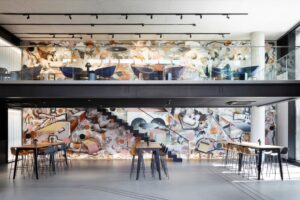 Combining cartoon imagery and graffiti with geometric shapes and cultural references to King’s Cross, the site-specific work projects a dynamic urban attitude.
Combining cartoon imagery and graffiti with geometric shapes and cultural references to King’s Cross, the site-specific work projects a dynamic urban attitude.
The work is presented as an architectural element within the space, drawing on the local built environment and encouraging people to move around the space to discover different aspects of the painting.
Office spaces benefit from natural light on three sides – all four on the upper level – and every floor has openable windows to allow for natural cross ventilation.
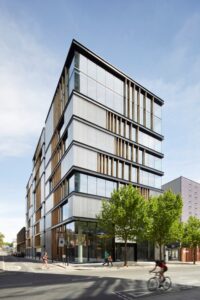 Exposed concrete ceilings continue the industrial aesthetic, with suspended lighting tracks directing light up and down. Circulation on each level is marked with a backlit perforated metal screen, leading to the lift lobby and toilets.
Exposed concrete ceilings continue the industrial aesthetic, with suspended lighting tracks directing light up and down. Circulation on each level is marked with a backlit perforated metal screen, leading to the lift lobby and toilets.
A 140sqm private roof terrace with planters and feature linear floor lighting is created on the upper level, offering views across the skyline. WC’s are designed as superloos, self-contained cubicles that include a black Corian worktop and splashback, sink, large mirror and vertical feature lights.
The back wall of each cubicle is lined with panels of natural ply featuring an engraved pattern depicting freight containers. 300sqm of roof space has been planted with wildflowers and grasses chosen to support local populations of birds, bees, and butterflies.
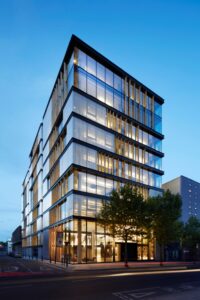 On top of this planted bed are 120 solar panels, with a further 80 panels on the south façade, providing the building with a sustainable energy source. Capable of responding to the needs of growing companies, the building is presented as an adaptable collection of working spaces offering units ranging in size from 150 to 680sqm.
On top of this planted bed are 120 solar panels, with a further 80 panels on the south façade, providing the building with a sustainable energy source. Capable of responding to the needs of growing companies, the building is presented as an adaptable collection of working spaces offering units ranging in size from 150 to 680sqm.
Rolling Stock Yard tenants have access to generous cycle storage, showers, lockers, and a reception café and breakout space. Branding and wayfinding were conceived as an evolution of the architecture and interiors concept, by Squire & Partners’ in-house branding agency Mammal.
Referencing the railways and freight industry of King’s Cross, Mammal established a palette of rust orange, blue, and white with a graphic identity based on parallel and converging lines.
All images courtesy of Jack Hobhouse / Squire & Partners.

